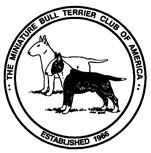|
Update on
Miniature Bull Terrier Left Heart Abnormalities
The following
report was submitted by B.K. Lefbom, DVM, DACVIM (Cardiology) & S.L.
Rosenthal, DVM, DACVIM (Cardiology) Chesapeake Veterinary Cardiology
Associates, Springfield, VA, Annapolis & Timonium, MD, M.B. Lesser, DVM,
DACVIM (Cardiology) Advanced Veterinary Care Center, Lawndale, CA.
Over the past few
years, independent cardiology groups have been noticing abnormalities in the
Miniature Bull Terrier (MBT) breed. We are currently consolidating our data
to obtain relevant numbers of dogs and generate the most meaningful data
possible. As we discussed at the meeting in San Diego, several noticeable
abnormalities are present when we screen MBT's echocardiographically.
The most prominent
abnormality is a consistent increase in the velocity of blood flow through
the left ventricular outflow tract (blood flow from the left ventricle out
to the body). Accepted normal values in other breeds generally range from 1
to 1.5 m/sec. Equivocal velocities are from 1.7 to 2.2 m/sec. Based on the
data thus far collected, over half (54%) of all MBT's screened fall into the
equivocal range and almost all of the remaining dogs (41%) are distinctly
abnormal. Some basic math reveals only 5 % of all MBT's screened thus far
have normal LV outflow velocities.
Concern has arisen
because multiple operators have screened some dogs and alternate numbers are
generated. Based on the Doppler principles in place for velocity analysis,
the only way to err is on the low side. There is virtually no way a
cardiologist can generate a falsely high number. The most accurate
measurement of the outflow area is obtained via the subcostal view. This
view requires the transducer to be placed on the abdomen and images the
heart deep to the liver. If this technique is not used, the alignment of the
ultrasound beam may be less than ideal and a lower number will be generated.
Review of our data consistently shows a higher velocity is obtained when the
subcostal approach is taken.
Another potential
cardiac concern in Miniature Bull Terriers is the conformation of the mitral
valve apparatus. A significant percentage of dogs (92% in one screened
group) have shortened mitral valve chordae and/or a small amount of mitral
regurgitation. Also, many affected dogs do not have audible murmurs.
Therefore complete echocardiographic examination is required to evaluate for
these potential problems.
None of the dogs
screened thus far have been symptomatic cardiac disease nor are they
expected to develop congestive heart failure. A single dog has experienced
sudden death although we do not have confirmation of the exact cause at this
time. The overwhelming concern for the breed is that propagation and
intensification of minor abnormalities can be predicted to occur.
Thus, continued
matings of minimally affected dogs could produce moderate to severely
affected offspring. The conclusions made so far suggest that breeding
animals should be screened aggressively prior to their use. If breeding
animals are found to have multiple mild defects or LVOT velocities > 2.2
m/sec, they should be considered at risk for producing more significantly
affected offspring. In these situations it is the responsibility of the
breeder to make the appropriate breeding decision. |
